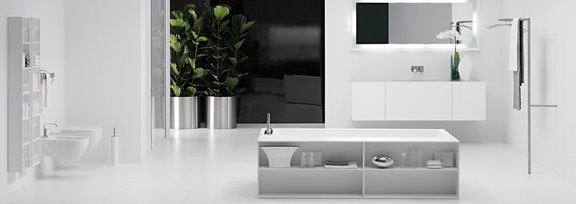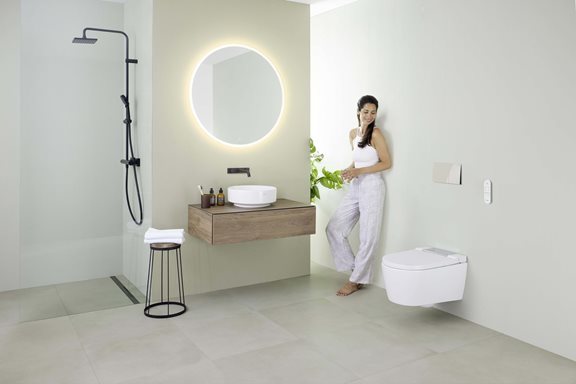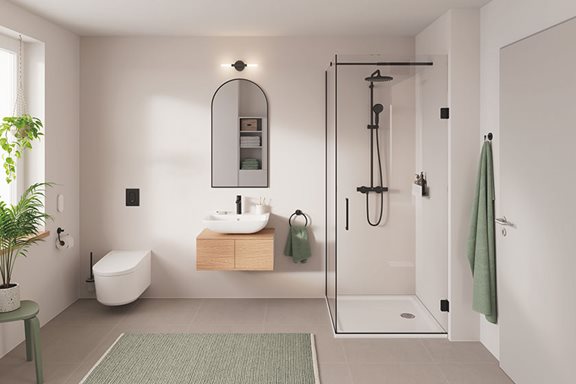Design your bathroom: save time and money | Facq
You can design your own bathroom, but that option requires careful planning and a budget. Follow Facq’s step-by-step guide.
Design your bathroom: a step-by-step guide to save time and money
Designing your own bathroom can be a fulfilling task. It can lead to a sense of personal satisfaction, while providing an opportunity to fully personalise this space in the home, to meet your tastes and needs. Through careful planning and a little creativity, you can transform your bathroom into a place that is both functional and attractive, while controlling your budget.
Step 1: Initial planning
Define your needs and wishes
Before you start designing your bathroom, think carefully about what you want to achieve. Do you want a spa-like bathroom where you can relax and unwind? Or would you prefer an ultra-modern room featuring all the latest technologies? Think about your must-haves: a large bathtub, a walk-in shower, or maybe two washbasins to speed up your morning routine. You can find lots of ideas, whether big or small, on sites like Pinterest. Or you could browse design and decor magazines or catalogues to find your own personal style and ambience.
Choice of materials
The materials you select must be attractive and practical. For the floors and walls, ceramic or porcelain tiles, or natural stone such as marble, are very popular because of their durability and ease of cleaning. You should choose bathroom fittings that are well made, to ensure they will be durable.
Budget and financial planning
It is very important to do financial planning before you build a new bathroom, as this will guarantee that the project will be carried out and finalised, without going over the set budget. Below, you will find a detailed estimate of the average budget required for different levels of finish and complexity, when creating a new bathroom.
Budget estimates
- For a basic construction: To complete a bathroom that is functional and without frills, featuring basic installations and material of a standard quality, the budget can vary from €5,000 to 10,000. This budget will cover the essential fittings, e.g. plumbing, simple tiling, basic lighting, a shower, toilets and washbasin.
- For a mid-range construction: If you want better quality finishes, more durable alternatives, or more modern fittings, e.g. mid-range taps and better tiling, you should foresee a budget of between €10,000 and 20,000. This should also enable enhanced insulation, good ventilation and maybe a few luxury and stylish items, such as a hairdryer or a small vanity washbasin.
- For a top of the range construction: For luxury projects that include top of the range materials, refined equipment (e.g. a rain shower, spa bath, or home automation systems to manage the temperature and lighting), then the budget can reach at least €20,000. This kind of bathroom may also include customised elements, unique architectural designs and complex installations.
Our advice on managing your budget
- Plan every detail: Before getting started on your project, you should clearly define your requirements and preferences. Select the materials, finishes and equipment in advance, as this will deter you from making impulsive and costly purchases during the project.
- Anticipate hidden costs: Don’t forget to include unexpected costs such as permit fees, design costs and possibly rental costs during construction.
- Keep monitoring: Keep a watchful eye on expenses as the work progresses. If necessary, you can call on project management software or a simple Excel spreadsheet to track the costs and adjust the budget accordingly.
- Contingencies reserve: As with any construction job, surprises can happen. It’s wise to set aside 10-20% of your total budget, to deal with unexpected events.
Design and construction schedule
It’s crucial to plan the schedule for your bathroom project. The design phase, which includes gathering ideas and creating detailed plans, may last as long as six weeks. Once this step is over, the construction itself can vary from four to 12 weeks, depending on the project’s complexity. You should always allow a margin for anything unexpected, by adding two to three extra weeks, to make up for any delays. You can ensure that all the materials necessary will be available and that all the permits have been granted prior to the start of the work, by overseeing efficient coordination between the design and construction phases. This will guarantee a smooth transition and completion of the work within the foreseen period.
Step 2: Design and layout
Use design tools for bathrooms
You can call on free online 3D tools to design your bathroom. These tools, which are very helpful for interior design novices, allow you to create and visualise a space, experiment with different layouts and easily try out various ideas and elements in order to maximise the use of space available. You can envisage how the different configurations will affect the room’s accessibility and how it looks, before making any final decisions.
Seek advice from bathroom professionals
Even if you take responsibility for designing your bathroom, you should listen to the advice and ideas of professionals. Plumbers, electricians and designers can help you and offer useful tips on avoiding costly mistakes and on improving your bathroom’s functionality.
Compliance with standards and rules
Make sure that all the work complies with local building codes for a bathroom, particularly for the electricity and plumbing. This will guarantee the room’s safety and its legal compliance, which is essential if you ever put your house or apartment up for sale.
Step 3: Doing the work and installation
When your bathroom plan has been finalised and all the materials, parts and equipment are ready, you can move on to the work and installation stage. If you require some extra advice on effectively managing this vital stage of the project, you can find it below.
Planning the work site
You must effectively manage the work site, to ensure that the work is completed well. It’s important to carefully coordinate the arrival of various equipment and the working time of the different tradespeople. You should draw up a detailed work schedule that includes all workers, as this will prevent any conflicts and downtime. Make sure that each professional has access to the work space when they need it. This often calls for a very detailed plan, when various tradespeople are working in a small space.
Monitoring and adjustments
Be proactive during the construction phase. You should regularly visit the site, to ensure that everything is going to plan. In this way, you can spot any potential problems as soon as they arise and ask for adjustments to be made before it is either too late or too expensive to carry out remedial work. Regularly contact the firms and workers and be open with them, as this can help to keep the project on track and within the budget.
Final touches
The finishes are vital for your bathroom’s style, beauty and functionality. They include the paint, installation of the bathroom fittings, electrical connections for lighting, plus accessories such as mirrors, towel holders, towel racks and shelves. Take time to look at every detail with professionals, and make sure that everything is perfectly fitted and operates properly. This is also a good opportunity to make any final changes to the way the room looks, in order to ensure that your bathroom space really matches your first vision.
Further advice for a personalised bathroom
Environmentally friendly choices
Select energy-saving equipment, use products that are recycled or easy to recycle, and consider alternatives like solar-powered boilers in order to reduce your bathroom’s environmental footprint.
Innovative technologies
You might consider installing modern technologies such as water-saving flush toilets, water-saving sensor taps, or an underfloor heating system that improves comfort while being energy-efficient. Technologies like this not only improve day-to-day comfort, they can also increase the resale value of your house or apartment.
Conclusion
By creating your own bathroom, you can radically transform the style of this space. This also allows you to control your budget and adapt each detail to your needs and wishes. You can make the bathroom of your dreams, through careful planning, the use of modern design tools and by seeking the advice of professionals whenever necessary. A project like this will increase the value of your property. It will also give you a personalised space, one that you will use daily for relaxation and to recharge your batteries.
FAQ
How long will it take to create and install a bathroom?
The time required to create and complete the work on your bathroom can vary considerably, depending on the project’s style and complexity. The design phase can take a few weeks, while the installation may last several days or weeks. Give yourself the time to talk to experts, as well as for design adjustments and any delays in the building.
What budget will I need to renovate my bathroom?
The cost can vary mainly according to the equipment chosen, the size of the bathroom and the complexity of the design. A basic budget starts at around a few thousand euro and will cover simple renovation. This can stretch to several tens of thousands of euro for top of the range or large-scale projects. You should ideally foresee a 10-20% margin for anything unexpected.
Should I hire an architect or a designer to create my bathroom?
This is not essential, but it can help you, particularly if you envisage structural modifications or if you want to achieve a highly specific design. A professional can also help you to navigate and find your way through local regulations, as well as to optimise the space and materials used in your bathroom.
What are the best materials to use for a sustainable bathroom?
For humid areas, you should select moisture-resistant, easy-to-clean solutions such as ceramic or porcelain tiles, natural stone and glass. For the vanity washbasin and storage units, solutions such as treated wood or PVC are a good option.
How can I ensure that my bathroom will be environmentally friendly?
Choose appliances that don’t use much water, e.g. dual-flush toilets and energy-saving showerheads. Also consider the use of recycled or local materials, and renewable energy solutions such as solar-powered boilers.
What are the common mistakes to avoid when designing a bathroom?
A common mistake is to under-estimate the budget, forget about practical aspects like storage and ventilation, and to choose solutions that are not appropriate for a humid environment like a bathroom. You must also ensure you comply with local building codes, to avoid any legal or safety issues.
How can I make the best use of a small bathroom space?
Select light colours, mirrors and smart storage solutions to create a feeling of space. You can also maximise use of the space through wise choices, e.g. sliding doors, built-in shelving and multi-functional furniture.
Book an appointment for bespoke advice!
Our experts are here to help you make the best choices.
Keep up to date
News, trends and special offers...
Subscribe to our monthly newsletter




